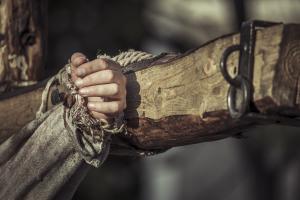Products Showing 24 of 111

Lesson 7.4
Jesus told His disciples that anyone who wished to follow Him would have to take up his own cross. Many of the early believers did just that, willingly following in their rabbi's footsteps even when it meant certain death. Count their cost as you ...

Lesson 8.4
As God's plan of deliverance from Egypt for the Israelites unfolded, He began their "basic training," cultivating for Himself a people marked by shalom through obedience to His kingship. The very route they took out of Egypt illustrates ...

Lesson 9.4
Over and over in the Bible, God used the image of fire to illustrate His power, holiness, and passionate love for His people. The fire on Mount Sinai when Moses received the Ten Commandments was just such a display of power, highlighting the holin...

Lesson 10.4
Interestingly, when God chose a person to lead His people out of Egypt by the power of His word, He chose Moses, a man with a speech impediment. In this lesson, consider the implications of allowing His strength to work in weakness as you discover...

Lesson 11.4
In the story of God making Himself known to His people, Passover is a foundational element. As the continuation of this redemptive process, the Lord's Supper finds its most profound meaning when taken in the context of Passover imagery. In this le...

Lesson 12.4
Some of the dangers in the desert are slow to develop: the build-up of scorching heat from the sun, the slow evaporation of streams, the depletion of food supplies. Others are more sudden; the flash floods of desert wadis can come out of nowhere, ...

Lesson 13.4
Of all the parables Jesus told, the one we call "The Prodigal Son" is possibly the most famous. In the story, a younger son demands his inheritance from his father and leaves the family behind, taking his riches to a far country. The imp...

Lesson 14.4
It was customary in the Roman world to consider the emperor a divine being. New emperors would claim this status because they believed that when the previous ruler died, he would ascend to heaven to be seated among the gods, making ...

15.4
At one point during his ministry, the Apostle Paul was at the Temple Mount in Jerusalem. He was accused by some Jews of bringing a Gentile into the courts where only Jews were allowed. He hadn’t, but they thought he did and a riot started. W...

16.4
The Jews of Jesus’ day lived together as extended families, sharing the family resources. The task of the father was to use those resources to care for everyone who lived in “the father’s house,” as they called it – r...

Lesson 6.5
In ancient times, people craved words of counsel and knowledge from their gods. The city of Didyma in what is now modern-day Turkey functioned as one of three main oracles, places where ordinary people would travel to hear advice and predictions o...

Lesson 7.5
In his letter to the Corinthian church, Paul wrote that the body of Christ is a unit made up of many parts and when one part suffers, the whole body suffers along with it. Are you aware of the suffering of brothers and sisters, both in your own ex...

Lesson 8.5
The themes of the exodus experience look forward to the good news of God's kingdom, which Jesus would later proclaim. In this lesson, journey beyond the Red Sea and into the desert with the Israelites as you explore the gospel in this context, cel...

Lesson 9.5
The covenant at Sinai is often thought of as a wedding between God and His people, between God and the bride He chose for Himself. This became the picture of God's redemptive plan for humankind, fully realized in Jesus' death and resurrection. In ...

Lesson 10.5
The blessings of a good land can often obscure the hard-learned lessons of the desert. In a sense, the real test for the Israelites came after they had crossed into the Promised Land, when their need for God was less obvious throughout daily life....

Lesson 11.5
The Passover Sedar employs four symbolic cups to help the Jews remember the miraculous ways that God delivered His people from the hand of Pharaoh. In the Garden of Gethsemane, Jesus asked the Father to take away the cup placed before Him, a "...

Lesson 12.5
After their escape from the might of Egypt, the Israelites spent forty years wandering in the desert of Sinai. But were they really wandering? The Bible says that God led them like a flock, like sheep through the desert with a pillar of cloud by d...

Lesson 13.5
Throughout His ministry, Jesus' compassion for sinners and those considered unclean raised the eyebrows of the Pharisees and the teachers of the law. God's word warned His people not to touch any unclean thing, and they could not understand why Je...

Lesson 14.5
After His resurrection, Jesus spent about 40 days with His followers in Jerusalem and back in the Galilee region, where they had received much of their training. He explained that after His ascension to heaven, He would send them a ...




























